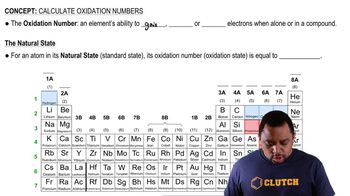Here are the essential concepts you must grasp in order to answer the question correctly.
Oxidation Numbers
Oxidation numbers are a way to keep track of electrons in chemical compounds. They indicate the degree of oxidation of an atom in a molecule, helping to determine how electrons are transferred during reactions. The oxidation number of an element can be positive, negative, or zero, depending on its electron gain or loss relative to its elemental state.
Recommended video:
Rules for Assigning Oxidation Numbers
There are specific rules for assigning oxidation numbers, such as: the oxidation number of an atom in its elemental form is zero, the oxidation number of a monoatomic ion is equal to its charge, and in compounds, the sum of oxidation numbers must equal the overall charge of the molecule or ion. For example, in hydroxide (OH-), oxygen typically has an oxidation number of -2, which helps in determining the oxidation state of other elements.
Recommended video:
Polyatomic Ions
Polyatomic ions are ions composed of two or more atoms that are covalently bonded and carry a net charge. Understanding the structure and charge of polyatomic ions, such as hydroxide (OH-), is crucial for assigning oxidation numbers in compounds. In the case of Cr(OH)4-, recognizing that the hydroxide group contributes a charge of -1 is essential for calculating the oxidation state of chromium.
Recommended video:
Polyatomic Ion Variations
 Verified step by step guidance
Verified step by step guidance


